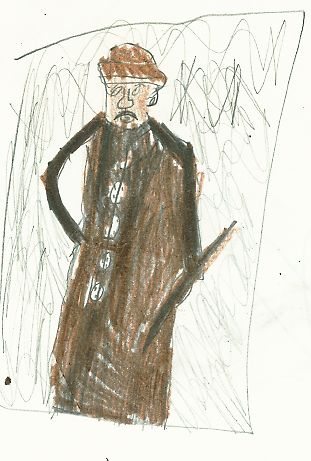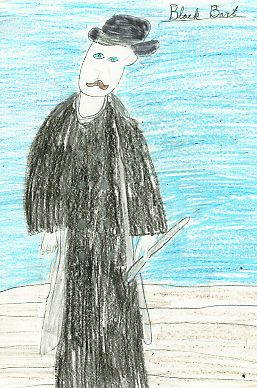By Sami-Jo |
By Kent |
Black Bart, By Sam |
Black Bart was a polite man. The only problem was he stole from people. He had success 27 times, and on his 28th time he finally got caught. By Sam
|
By Sarada |
Dr. Anderson, the Wells Fargo Historian, taught us about Charles E. Boles. Charles was also called Black Bart. He was wearing a flour bag whenever he planned to rob one of the Wells Fargo stagecoaches. He carried scary things like a weapon, but he made nobody get hurt. He robbed the stagecoaches 27 times. He robbed stagecoach people and found some of the money, but not all. He always left a note behind after robbing. His notes didn't fool the stagecoach riders. It turned out that these notes helped the people of the Wells Fargo Bank. Finally, he left behind a handkerchief, which the bank people discovered in the laundry. He was soon caught and put in prison. After 5 to 6 years in prison, the Wells Fargo Bank members let Charles free. He went somewhere else. |
Black Bart robbed 27 stagecoaches and took its treasure boxes every single time. He scouted and looked for the stagecoaches without the rifle guys on top. He wore a flour sack with eye holes in it to not reveal his identity. Black Bart had a family, but when he fought in the civil War, he never saw his family again. Black Bart always carried a shotgun with him but he never killed anybody. He only shot the treasure box locks. When he stole the 27 treasure boxes, he left 27 poems behind by the stagecoaches. He signed it Black Bart, the PO8. (PO8= Poet). He was going to try to steal the treasure for the 28th time, but he dropped his hankie at the scene of the crime. A detective named James Hume found his handkerchief. and tracked down every laundry he cleaned his hankie at, and waited for him at his laundromat. He was captured and was sent to San Quentin prison for 6 years. When he got out of prison, he wasn’t ever seen again, ever. By Alexandra |
Today Dr. Andy Anderson came to our school, and taught us about California history, between 1820-1920. He also talked about Charles E. Boles, also known as Charle Bolton and Black Bart. By Jane |
Dr. Anderson, the Wells Fargo Historian, taught us about Black Bart. His real name was Charles E. Boles. He would say, “Drop the treasure box” to the stagecoach drivers, and they would drive off. He only used his gun to open the money box. He would jump out of the bushes with a flour sack over his head. He was polite and did not injure or kill people. I think black Bart is interesting because he would scare people and wear a flour sack over his head. I also learned more about Charlotte Parkhurst. What I learned about “Charley” Parkhurst: I learned that Charley had 1 eye and wore a patch on her eye. They didn’t By Aviva
|
Black Bart, By Aviva |
Dr. Anderson, the Wells Fargo Historian, came to see us. He told us about Charles Boles. The name he went by was Black Bart. He did not kill anyone. Black Bart wore a flour sack on his head. It was a disguise to keep his identity safe. How they caught him was they found where he did laundry. That’s what I learned about at this interview. By Joe |
Today, Andy came to our school to talk about Wells Fargo and American
|
Dr. Anderson, the Wells Fargo Historian, told us about Black Bart. Black Bart was a stagecoach robber. He served in the Civil War, but after the war he deserted his family. They never saw him again.
|
We met Dr. Anderson, the Wells Fargo Historian. Black Bart, AKA Charles E. Boles, was a polite gentleman who went to fight in the Civil War and afterwards |
Charles E. Boles, AKA Black Bart, stole money 27 times from the Wells Fargo stagecoaches. He had a family, but after he went to the Civil War, he left his family and went out West. He wanted to get rich, so that's when he started taking money from the stagecoaches. On his 28th time, he dropped his handkerchief, and they tracked him down to where he did his laundry. They went and waited for him to come, and then they took him to San Quentin Jail. He had to wait six years to get out of jail, and when he got out, he disappeared. |
Dr. Anderson provided us with information. Black Bart surrendered, and when he got to jail, he didn't fight. By Marissa |
Here is the real Charles Boles, AKA Black Bart.
|
More Questions We Would Like to Ask Black Bart 1. If you could go back in time, would you still make the choice to be a robber? |
| Dr. Anderson taught us many things. We especially loved hearing about stagecoaches and Charlotte (Charley) Parkhurst. |
|---|
Dr. Andy Anderson, the Wells Fargo Historian, came to our school and taught us about driving a stagecoach. To make it go, you say “HYAAA!!!” Once you get to the passengers’ destination you say “WHOA!!!!” |
Dr. Anderson, the Wells Fargo Historian, told the fourth grade classes about how to drive a stagecoach. You say HYAAAA to get the horses moving and WHOA to get them to stop. |
Dr. Anderson, the Wells Fargo Historian, taught us 4th graders about how to get a stagecoach going and stopping. "Hyaa! Hyaa!" the driver would say. "Hyaa" means "Go," and "Whoa!" means stop. In case of an emergency, the driver uses the brakes. By Reza
|
Dr. Andy, the Wells Fargo Historian, taught us how to drive a stagecoach. If you want to go, you say "Hyaa!" If you want to stop, you say, "Whoa." The people fell for it, and she was allowed to drive the stagecoach. By Evan
|

A stagecoach, by Evan
Back to Black Bart, and Other Adventures from Wells Fargo's History


